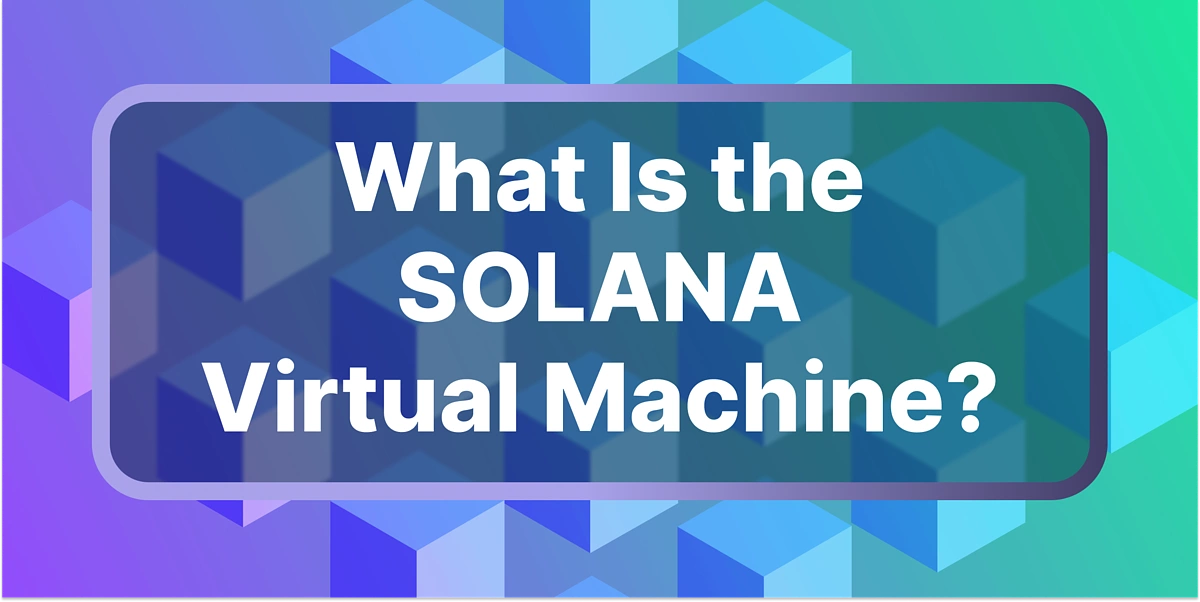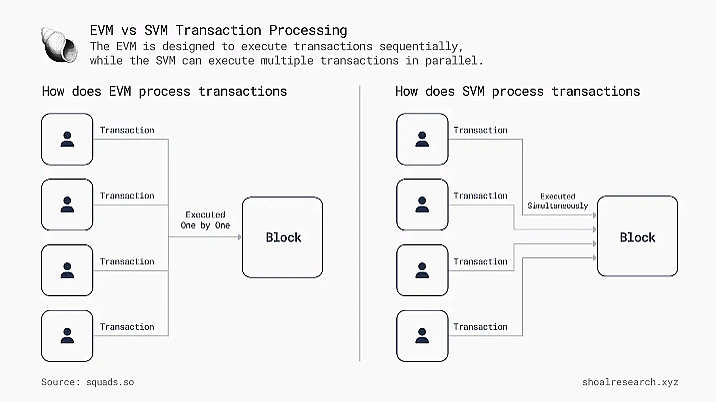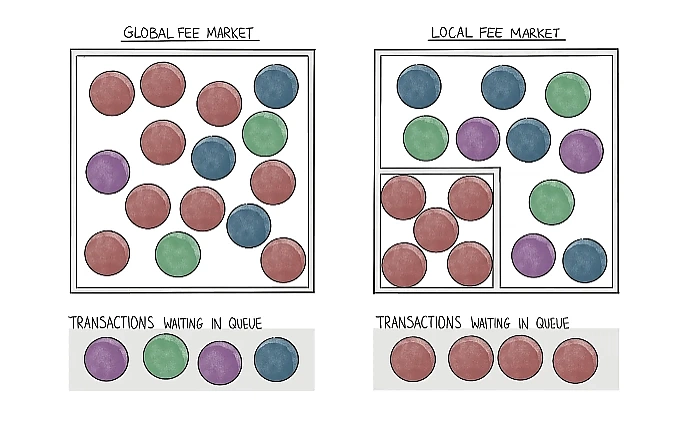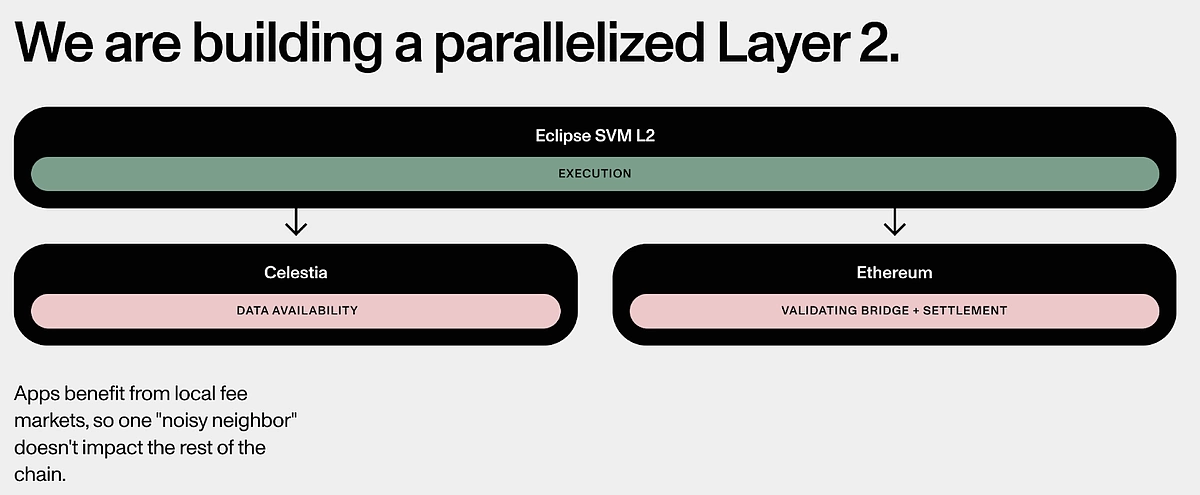 |
|
 |
|
 |
|
 |
|
 |
|
 |
|
 |
|
 |
|
 |
|
 |
|
 |
|
 |
|
 |
|
 |
|
 |
|
솔라나 가상 머신(SVM)은 솔라나 블록체인의 스마트 계약 실행 환경으로, 병렬 처리 모델을 활용해 초당 수천 건의 트랜잭션을 처리합니다. 이를 통해 솔라나 기반 dApp이 높은 처리량과 낮은 트랜잭션 수수료를 달성할 수 있습니다. SVM은 Rust 프로그래밍 언어로 작동하고 다중 스레드 트랜잭션 처리 모델을 구현하여 네트워크의 유효성 검사기가 트랜잭션을 동시에 처리할 수 있도록 하여 효율성과 확장성을 향상시킵니다.

What Is the Solana Virtual Machine (SVM)?
The Solana Virtual Machine (SVM) is the execution environment on the Solana blockchain, utilizing a parallel processing model for dApps that enables Solana to handle thousands of transactions per second.
솔라나 가상 머신(SVM)이란 무엇입니까?솔라나 가상 머신(SVM)은 솔라나 블록체인의 실행 환경으로, 솔라나가 초당 수천 건의 트랜잭션을 처리할 수 있도록 하는 dApp용 병렬 처리 모델을 활용합니다.
Key Takeaways
The Solana Virtual Machine is the execution environment for smart contracts on the Solana blockchain. It enables the Solana blockchain to handle thousands of transactions per second.
주요 내용 Solana 가상 머신은 Solana 블록체인의 스마트 계약을 위한 실행 환경입니다. 이를 통해 솔라나 블록체인은 초당 수천 건의 거래를 처리할 수 있습니다.
A virtual machine is a software emulation of a computer system that executes smart contracts within a secure environment.
가상 머신은 보안 환경 내에서 스마트 계약을 실행하는 컴퓨터 시스템의 소프트웨어 에뮬레이션입니다.
Solana VM is written in Rust programming language and runs a parallel processing model for applications. According to the developers, this enables greater performance and network capacity.
Solana VM은 Rust 프로그래밍 언어로 작성되었으며 애플리케이션을 위한 병렬 처리 모델을 실행합니다. 개발자에 따르면 이는 더 큰 성능과 네트워크 용량을 가능하게 합니다.
This article discusses how the Solana Virtual Machine works and other key features.
이 글에서는 Solana 가상 머신의 작동 방식과 기타 주요 기능에 대해 설명합니다.

Smart contracts are a key part of the blockchain. Originally, blockchains were designed as a giant alternative payment network for one-way transactions between peers. With the creation of blockchain virtual machines (VM), it enabled smart contracts to be built on top of blockchains. From then on, the blockchain became a base layer upon which anything could be built.
스마트 계약은 블록체인의 핵심 부분입니다. 원래 블록체인은 피어 간의 단방향 거래를 위한 거대한 대체 결제 네트워크로 설계되었습니다. 블록체인 가상 머신(VM)이 생성되면서 블록체인 위에 스마트 계약을 구축할 수 있게 되었습니다. 그때부터 블록체인은 무엇이든 구축할 수 있는 기본 레이어가 되었습니다.
Ethereum developed the first instance of a virtual machine for blockchain technology. The Ethereum Virtual Machine (EVM) has seen wide adoption, with popular Layer 1 blockchains such as BNB Smart Chain, Avalanche and Tron being built as a fork of the EVM, not to mention the many EVM-compatible Layer 2s being built today. Through the EVM, developers can easily port existing applications across EVM-compatible blockchains with minimal code changes.
이더리움은 블록체인 기술을 위한 최초의 가상 머신 인스턴스를 개발했습니다. EVM(Ethereum Virtual Machine)은 오늘날 구축되고 있는 많은 EVM 호환 레이어 2는 말할 것도 없고 BNB 스마트 체인, Avalanche 및 Tron과 같은 인기 있는 레이어 1 블록체인이 EVM의 포크로 구축되면서 널리 채택되었습니다. EVM을 통해 개발자는 최소한의 코드 변경만으로 EVM 호환 블록체인 전체에 기존 애플리케이션을 쉽게 포팅할 수 있습니다.
However, the Solana Virtual Machine (SVM), one of the newest prototypes of a virtual machine built to power smart contract blockchains, is emerging as a competitor. According to developers, Solana VM was built from scratch with technologies that focus on high performance and overall agility.
그러나 스마트 계약 블록체인을 지원하기 위해 구축된 가상 머신의 최신 프로토타입 중 하나인 솔라나 가상 머신(SVM)이 경쟁자로 떠오르고 있습니다. 개발자에 따르면 Solana VM은 고성능과 전반적인 민첩성에 초점을 맞춘 기술을 사용하여 처음부터 구축되었습니다.
Understanding the Solana Virtual Machine (SVM)
The Solana Virtual Machine handles smart contract transactions for the Solana blockchain. Built with Rust programming language, the developers claim that the SVM is adjusted for high-demand conditions and designed to handle transactions in the most efficient way. As a virtual machine, the SVM operates as a virtualized processing machine tasked with the role of handling smart contract deployment, processing transactions, and other requests from these contracts.
솔라나 가상 머신(SVM) 이해 솔라나 가상 머신은 솔라나 블록체인의 스마트 계약 트랜잭션을 처리합니다. Rust 프로그래밍 언어로 구축된 개발자들은 SVM이 높은 수요 조건에 맞게 조정되고 가장 효율적인 방식으로 트랜잭션을 처리하도록 설계되었다고 주장합니다. 가상 머신으로서 SVM은 스마트 계약 배포, 트랜잭션 처리 및 이러한 계약의 기타 요청을 처리하는 역할을 수행하는 가상화된 처리 머신으로 작동합니다.
These transactions are state change requests, where the Solana VM computes requests and updates the overall state of the blockchain after each run. In summary, the SVM is the Solana blockchain’s execution environment. It acts in synergy with the consensus layer of the Solana blockchain to provide a dynamic network to build and run for Web3 applications.
이러한 트랜잭션은 상태 변경 요청으로, Solana VM은 요청을 계산하고 각 실행 후 블록체인의 전체 상태를 업데이트합니다. 요약하자면, SVM은 솔라나 블록체인의 실행 환경입니다. 이는 솔라나 블록체인의 합의 레이어와 시너지 효과를 발휘하여 Web3 애플리케이션을 구축하고 실행할 수 있는 동적 네트워크를 제공합니다.
The SVM supports diverse smart contract applications including GameFi, DeFi applications, and other decentralized applications. Like the EVM, Solana VM is a modular machine, where it can be deployed alongside other components, e.g. data availability / consensus layer, to build decentralized networks with little or no changes to its original form.
SVM은 GameFi, DeFi 애플리케이션 및 기타 분산 애플리케이션을 포함한 다양한 스마트 계약 애플리케이션을 지원합니다. EVM과 마찬가지로 Solana VM은 모듈식 시스템으로, 다른 구성 요소와 함께 배포할 수 있습니다. 데이터 가용성/합의 레이어, 원래 형태를 거의 또는 전혀 변경하지 않고 분산형 네트워크를 구축합니다.
To better understand the Solana VM, let's take a look at what a Virtual Machine actually is.
Solana VM을 더 잘 이해하기 위해 가상 머신이 실제로 무엇인지 살펴보겠습니다.
What Is a Virtual Machine?
Virtual machines (VMs) are a software emulation of the computer system, which can run an operating system, along with installing and executing applications. Traditionally, users ran a VM as sandbox environments that are fully isolated from their main computer operating system.
가상 머신이란 무엇입니까?가상 머신(VM)은 응용 프로그램 설치 및 실행과 함께 운영 체제를 실행할 수 있는 컴퓨터 시스템의 소프트웨어 에뮬레이션입니다. 전통적으로 사용자는 기본 컴퓨터 운영 체제와 완전히 격리된 샌드박스 환경으로 VM을 실행했습니다.
While traditional virtual machines are isolated sandboxes, blockchain virtual machines function as the execution layer of the network for decentralized applications. Blockchain VMs are decentralized, where nodes on the network run an instance of the blockchain’s virtual machine on their device, compute state changes, and monitor state changes suggested by other validators to achieve consensus, ensuring that the records of transactions are properly recorded on the network.
기존 가상 머신은 격리된 샌드박스인 반면, 블록체인 가상 머신은 분산형 애플리케이션을 위한 네트워크 실행 계층 역할을 합니다. 블록체인 VM은 분산되어 네트워크의 노드가 장치에서 블록체인의 가상 머신 인스턴스를 실행하고, 상태 변경을 계산하고, 합의를 달성하기 위해 다른 검증자가 제안한 상태 변경을 모니터링하여 트랜잭션 기록이 네트워크에 올바르게 기록되도록 보장합니다. .
How the Solana Virtual Machine Works
Blockchain users are always looking for secure blockchain networks that allow them to perform transactions as fast as possible while paying the cheapest possible fees. The Solana VM was developed to satisfy the throughput desires of blockchain users and developers, while balancing the blockchain trilemma of decentralization, scalability, and security.
솔라나 가상 머신 작동 방식블록체인 사용자는 항상 가장 저렴한 수수료를 지불하면서 최대한 빠른 속도로 거래를 수행할 수 있는 안전한 블록체인 네트워크를 찾고 있습니다. Solana VM은 블록체인 사용자와 개발자의 처리량 요구 사항을 충족하는 동시에 분산화, 확장성 및 보안이라는 블록체인의 트릴레마 균형을 맞추기 위해 개발되었습니다.
At the core of the Solana VM’s operation is the parallel transaction processing model. By structuring the Solana blockchain to process multiple transactions simultaneously instead of sequentially, it can offer higher throughput while enabling scalability.
Solana VM 운영의 핵심은 병렬 트랜잭션 처리 모델입니다. 여러 트랜잭션을 순차적이 아닌 동시에 처리하도록 솔라나 블록체인을 구성함으로써 확장성을 활성화하는 동시에 더 높은 처리량을 제공할 수 있습니다.
Parallel Execution with SeaLevel
SeaLevel is one of the most vital components within the Solana VM, as it allows the virtual machine to execute transactions in parallel. In contrast to the sequential execution model, the parallel transaction processing model processes transactions simultaneously by validators across the network. This allows the network to achieve higher throughput and enhanced scalability.
SeaLevelSeaLevel을 사용한 병렬 실행은 가상 머신이 트랜잭션을 병렬로 실행할 수 있도록 해주기 때문에 Solana VM 내에서 가장 중요한 구성 요소 중 하나입니다. 순차 실행 모델과 달리 병렬 트랜잭션 처리 모델은 네트워크 전체에 걸쳐 검증인이 동시에 트랜잭션을 처리합니다. 이를 통해 네트워크는 더 높은 처리량과 향상된 확장성을 달성할 수 있습니다.

One of the challenges around parallel execution is when two transactions that change the state of the same account are executed at the same time, which could lead to errors in the final computation of the account.
Source병렬 실행과 관련된 과제 중 하나는 동일한 계정의 상태를 변경하는 두 개의 트랜잭션이 동시에 실행될 때 계정의 최종 계산에서 오류가 발생할 수 있다는 것입니다.
For example, a wallet has a 0.5 SOL balance. There are two requests: a request to send 2 SOL to the account and a request to transfer 1 SOL from the account. If the transfer request is processed before the send request, errors can occur. Let’s look at how SeaLevel handles this situation.
예를 들어 지갑에는 0.5 SOL 잔액이 있습니다. 두 가지 요청이 있습니다: 2 SOL을 계정으로 보내달라는 요청과 계정에서 1 SOL을 이체해 달라는 요청입니다. 전송 요청이 전송 요청보다 먼저 처리되면 오류가 발생할 수 있습니다. SeaLevel이 이 상황을 어떻게 처리하는지 살펴보겠습니다.
With Sea Level, the Solana blockchain is able to process tons of transactions using the multiple-thread execution environment. Solana contracts are designed to be explicit in their effects, where the smart contracts state which part of the blockchain’s state is modified by each transaction. This enables the state machine to discern dependent transactions from independent transactions. Independent transactions can run without conflict since they don’t affect the same account. In the case of dependent transactions that affect the same account, they are processed in sequence to avoid conflicts.
Sea Level을 사용하면 솔라나 블록체인은 다중 스레드 실행 환경을 사용하여 수많은 트랜잭션을 처리할 수 있습니다. 솔라나 계약은 각 거래에 의해 블록체인 상태의 어느 부분이 수정되는지 스마트 계약이 명시하는 등 그 효과가 명시적으로 설계되었습니다. 이를 통해 상태 시스템은 종속 트랜잭션과 독립 트랜잭션을 식별할 수 있습니다. 독립적인 거래는 동일한 계정에 영향을 주지 않으므로 충돌 없이 실행될 수 있습니다. 동일한 계정에 영향을 미치는 종속 거래의 경우 충돌을 피하기 위해 순차적으로 처리됩니다.
The parallel transaction processing model allows the Solana blockchain to make maximum use of its resources, resulting in faster transaction processing and cheaper transaction fees. Moreover, to solve the issue of gas fee scalability faced by other virtual machines like the EVM, Solana blockchain operates a localized fee market.
병렬 트랜잭션 처리 모델을 통해 솔라나 블록체인은 리소스를 최대한 활용할 수 있어 트랜잭션 처리 속도가 빨라지고 트랜잭션 수수료가 저렴해집니다. 또한 EVM과 같은 다른 가상 머신이 직면한 가스 요금 확장성 문제를 해결하기 위해 솔라나 블록체인은 현지화된 수수료 시장을 운영합니다.
Localized Fee Market
In contrast to the global fee market, the localized fee market prevents a surge in activity from one smart contract from affecting the overall gas structure of the network.
현지화된 수수료 시장 글로벌 수수료 시장과 달리 현지화된 수수료 시장은 하나의 스마트 계약으로 인한 활동 급증이 네트워크의 전체 가스 구조에 영향을 미치는 것을 방지합니다.

In global fee markets, the whole network jostles for the same processing facility. In a scenario where one smart contract experiences high demand, the whole network suffers from the high request frequency from this smart contract. This leads to situations where the overall network fee swells when a popular project experiences a spike in activity, for example during an NFT mint for a popular project.
출처글로벌 수수료 시장에서는 전체 네트워크가 동일한 처리 시설을 두고 경쟁합니다. 하나의 스마트 계약이 높은 수요를 경험하는 시나리오에서는 전체 네트워크가 이 스마트 계약의 높은 요청 빈도로 인해 어려움을 겪습니다. 이로 인해 인기 있는 프로젝트의 활동이 급증할 때(예: 인기 있는 프로젝트의 NFT 민트 기간 동안) 전체 네트워크 수수료가 부풀어오르는 상황이 발생합니다.
To prevent this, Solana network implements a localized fee market. With this, each smart contract on the network operates a separate processing charge structure. In case of a spike in activity, transactions from the smart contract experience a spike in gas while the rest of the network still operates on the normal gas fee rate. This limits the impact of spikes in activity from related smart contract application(s), while the rest of the network remains largely unaffected.
이를 방지하기 위해 솔라나 네트워크는 현지화된 수수료 시장을 구현합니다. 이를 통해 네트워크상의 각 스마트 계약은 별도의 처리 비용 구조를 운영합니다. 활동이 급증하는 경우 스마트 계약의 거래에서 가스가 급증하는 반면 나머지 네트워크는 여전히 일반 가스 요금으로 운영됩니다. 이는 관련 스마트 계약 애플리케이션의 활동 급증으로 인한 영향을 제한하는 반면, 네트워크의 나머지 부분은 크게 영향을 받지 않습니다.
However during peak demand periods, where all dApps on the network are experiencing high activity, it still increases competition for remaining blockspace, and results in higher gas fees.
그러나 네트워크의 모든 dApp이 높은 활동을 경험하는 피크 수요 기간에는 남은 블록 공간에 대한 경쟁이 여전히 증가하고 가스 요금이 높아집니다.
Rollup Projects Using the SVM
Due to the high performance of the Solana VM, some rollup projects are choosing the SVM for execution, while retaining the security and decentralization of the main network. Here are some rollup networks using the Solana Virtual Machine.
롤업 프로젝트 SVMDue를 사용하여 Solana VM의 고성능을 구현하는 일부 롤업 프로젝트에서는 메인 네트워크의 보안과 분산화를 유지하면서 실행을 위해 SVM을 선택하고 있습니다. 다음은 Solana 가상 머신을 사용하는 일부 롤업 네트워크입니다.
Eclipse

식
Eclipse is an EVM-compatible Layer 2 zero knowledge network built using the Solana VM. According to the project, adopting the Solana VM model to build an extremely fast rollup and settling transactions on the Ethereum network enables them to combine the best of both worlds. While the Solana VM is able to process transactions faster than the EVM, Ethereum is known to be one of the most secure and decentralized smart contract networks. Therefore, Eclipse is able to achieve an improved speed compared to other EVM Ethereum rollup networks, while maintaining Ethereum-level security and decentralization.
Eclipse는 Solana VM을 사용하여 구축된 EVM 호환 레이어 2 영지식 네트워크입니다. 프로젝트에 따르면 Solana VM 모델을 채택하여 매우 빠른 롤업을 구축하고 Ethereum 네트워크에서 트랜잭션을 정산함으로써 두 세계의 장점을 결합할 수 있습니다. Solana VM은 EVM보다 빠르게 트랜잭션을 처리할 수 있지만 이더리움은 가장 안전하고 분산된 스마트 계약 네트워크 중 하나로 알려져 있습니다. 따라서 Eclipse는 Ethereum 수준의 보안과 분산화를 유지하면서 다른 EVM Ethereum 롤업 네트워크에 비해 향상된 속도를 달성할 수 있습니다.
Eclipse uses Celestia for its Data Availability (DA) layer. With Celestia, it aims to develop a stable network for the transfer of data between its execution environment and the Ethereum consensus system. It also uses RISC zero for its Zero knowledge proof computation. Using a ZK validity proof system, Eclipse hopes to achieve immediate verification for its transaction data on the mainnet. This eliminates the need for an extra fraud-proof system and a waiting interval for mainnet validation, as in the case of optimistic rollups.
Eclipse는 데이터 가용성(DA) 계층을 위해 Celestia를 사용합니다. Celestia를 통해 실행 환경과 Ethereum 합의 시스템 간의 데이터 전송을 위한 안정적인 네트워크를 개발하는 것을 목표로 합니다. 또한 영지식 증명 계산에 RISC 0을 사용합니다. Eclipse는 ZK 유효성 증명 시스템을 사용하여 메인넷의 거래 데이터에 대한 즉각적인 검증을 달성하기를 희망합니다. 이를 통해 낙관적 롤업의 경우처럼 추가적인 사기 방지 시스템과 메인넷 검증을 위한 대기 간격이 필요하지 않습니다.
At the time of writing, Eclipse is yet to launch publicly. According to a recent announcement from the Eclipse Foundation, the project has raised a total of $65 million to advance its efforts in building an SVM L2 for the Ethereum blockchain.
이 글을 쓰는 시점에는 Eclipse가 아직 공개적으로 출시되지 않았습니다. Eclipse 재단의 최근 발표에 따르면, 이 프로젝트는 이더리움 블록체인용 SVM L2 구축 노력을 발전시키기 위해 총 6,500만 달러를 모금했습니다.
MakerDAO
The MakerDAO community is on the verge of transition to a new chain for the complete reimplementation of the entire Maker Protocol built natively on a new, standalone blockchain.
MakerDAOMakerDAO 커뮤니티는 새로운 독립형 블록체인에 기본적으로 구축된 전체 Maker 프로토콜을 완전히 재구현하기 위해 새로운 체인으로 전환하는 직전에 있습니다.
While this is still in the community governance phase, a little information is already accessible. This includes MakerDAO co-founder Rune Christensen's preference for the Solana codebase as the prototype for the project’s new chain. In a proposal presented to the community by Rune, he cited the Solana blockchain’s resilience amidst the FTX exchange collapse and its optimization for the purpose of operating a singular, highly efficient blockchain as his major reason for picking the network’s codebase as his top choice.
아직 커뮤니티 거버넌스 단계에 있지만 이미 약간의 정보에 접근할 수 있습니다. 여기에는 MakerDAO 공동 창립자인 Rune Christensen이 프로젝트의 새로운 체인 프로토타입으로 Solana 코드베이스를 선호하는 것도 포함됩니다. Rune이 커뮤니티에 제출한 제안에서 그는 FTX 거래소 붕괴 속에서도 솔라나 블록체인의 탄력성과 단일하고 효율적인 블록체인 운영을 위한 최적화를 네트워크의 코드베이스를 최고의 선택으로 선택한 주요 이유로 언급했습니다.
Based on the community post, Cosmos is the other main contender, with its history of successful appchains using the Cosmos stack. However, he highlights that “Cosmos is not built around efficiency at its core in the same way Solana is which means it would cost more to maintain and keep performant.”
커뮤니티 게시물에 따르면 Cosmos는 Cosmos 스택을 사용하여 성공적인 앱 체인의 역사를 가진 또 다른 주요 경쟁자입니다. 그러나 그는 "Cosmos는 Solana와 같은 방식으로 효율성을 핵심으로 구축되지 않았습니다. 이는 성능을 유지하고 유지하는 데 더 많은 비용이 든다는 것을 의미합니다."라고 강조합니다.
If the project finally decides to adopt the Solana network codebase as the standard for its NewChain, this will serve as a bold statement of the positive impression the Solana VM have made on blockchain projects. Reiterating his preference for the Solana Codebase, Rune mentioned that developing a blockchain network with the Solana codebase will enable Maker to benefit from the resilience of the Solana blockchain and its community. Also, MakerDAO will be able to access a large pool of developers and resources to enable it to grow faster. The network will also create a communication path with the Solana network using bridges. Read the full proposal and discussion here.
프로젝트가 마침내 Solana 네트워크 코드베이스를 NewChain의 표준으로 채택하기로 결정한다면, 이는 Solana VM이 블록체인 프로젝트에 남긴 긍정적인 인상을 대담하게 표현하는 역할을 할 것입니다. Rune은 솔라나 코드베이스에 대한 자신의 선호도를 재차 강조하면서 솔라나 코드베이스로 블록체인 네트워크를 개발하면 메이커가 솔라나 블록체인과 커뮤니티의 탄력성으로부터 이익을 얻을 수 있을 것이라고 언급했습니다. 또한 MakerDAO는 더 빠르게 성장할 수 있도록 대규모 개발자 및 리소스 풀에 액세스할 수 있습니다. 또한 네트워크는 브리지를 사용하여 Solana 네트워크와의 통신 경로를 생성합니다. 여기에서 전체 제안 및 토론을 읽어보세요.
SVM vs. EVM
Solana network is creating a path for itself with the Solana VM. As the SVM ecosystem grows, it will compete with the much older EVM in terms of relevance and adoption. SVM and EVM are able to handle smart contract transactions for blockchain networks. Like the EVM, the SVM is gaining application on other blockchain networks apart from the Solana Network. Here, we take a look at some of their key differences.
SVM 대 EVMSolana 네트워크는 Solana VM을 사용하여 자체 경로를 생성합니다. SVM 생태계가 성장함에 따라 관련성과 채택 측면에서 훨씬 오래된 EVM과 경쟁하게 될 것입니다. SVM과 EVM은 블록체인 네트워크에 대한 스마트 계약 트랜잭션을 처리할 수 있습니다. EVM과 마찬가지로 SVM도 솔라나 네트워크를 제외한 다른 블록체인 네트워크에 적용되고 있습니다. 여기서는 몇 가지 주요 차이점을 살펴보겠습니다.
Programming Language: Rust vs. Solidity
The Solidity programming language was developed specifically for the EVM. It is an adaptation of the JavaScript programming language and is designed for ease of learning. Like JavaScript and many other high-level programming languages, Solidity is object-oriented, where variables are declared using objects and classes. As a programming language for smart contracts and the EVM, Solidity is designed with a focus on security.
프로그래밍 언어: Rust 대 Solidity Solidity 프로그래밍 언어는 EVM을 위해 특별히 개발되었습니다. 이는 JavaScript 프로그래밍 언어를 적용한 것이며 쉽게 학습할 수 있도록 설계되었습니다. JavaScript 및 기타 여러 고급 프로그래밍 언어와 마찬가지로 Solidity는 객체 지향적이며 객체와 클래스를 사용하여 변수가 선언됩니다. 스마트 계약 및 EVM을 위한 프로그래밍 언어인 Solidity는 보안에 중점을 두고 설계되었습니다.
In comparison, Rust is a general programming language. It can be used for smart contracts and other applications. While Rust is harder to learn, it is known for its agility and memory efficiency, along with its reputation for facilitating high performance and concurrency, which aligns with Solana’s focus on scalability.
이에 비해 Rust는 일반적인 프로그래밍 언어입니다. 이는 스마트 계약 및 기타 애플리케이션에 사용될 수 있습니다. Rust는 배우기가 더 어렵지만 민첩성과 메모리 효율성, 고성능 및 동시성을 촉진하는 것으로 알려져 있으며 이는 Solana가 확장성에 중점을 두는 것과 일치합니다.
Transaction Processing Model: Parallel vs. Sequential Processing
SVM is a multi-thread transaction processing environment. It makes extensive use of the resources available on the network to process transactions. Multiple transactions are executed concurrently across different validator cores and transaction proofs are submitted for consensus as the network attains a uniform state after each run. As outlined above, Solana SeaLevel ensures that the network avoids the complications of parallel processing while running this execution model.
트랜잭션 처리 모델: 병렬 처리와 순차 처리SVM은 다중 스레드 트랜잭션 처리 환경입니다. 트랜잭션을 처리하기 위해 네트워크에서 사용 가능한 리소스를 광범위하게 사용합니다. 여러 트랜잭션이 서로 다른 검증기 코어에서 동시에 실행되며, 각 실행 후 네트워크가 균일한 상태에 도달함에 따라 합의를 위해 트랜잭션 증명이 제출됩니다. 위에서 설명한 것처럼 Solana SeaLevel은 이 실행 모델을 실행하는 동안 네트워크가 병렬 처리의 복잡성을 방지하도록 보장합니다.
Conversely, the EVM processes transactions in sequence. Multiple transactions are queued and processed one after the other. The network validates transactions using one validator core at a time. Parallel processing has shown a significantly higher throughput than sequential transaction processing models. According to reported data, the Solana blockchain can process thousands of transactions per second – this is higher than the reported speed of the Ethereum blockchain and other instances of the EVM like L2 networks and POS sidechains.
반대로 EVM은 트랜잭션을 순서대로 처리합니다. 여러 트랜잭션이 대기열에 추가되어 차례로 처리됩니다. 네트워크는 한 번에 하나의 검증기 코어를 사용하여 트랜잭션을 검증합니다. 병렬 처리는 순차 트랜잭션 처리 모델보다 훨씬 더 높은 처리량을 보여줍니다. 보고된 데이터에 따르면 솔라나 블록체인은 초당 수천 건의 트랜잭션을 처리할 수 있습니다. 이는 이더리움 블록체인과 L2 네트워크 및 POS 사이드체인과 같은 다른 EVM 인스턴스의 보고된 속도보다 빠릅니다.
Efficiency: TPS vs. Transaction Fee
From information obtained from official network explorers, the Solana network has a transaction speed of over 2400 TPs, and transaction fees are as low as $0.001. Compared to EVM networks like Base Network with a transaction speed of about 47 TPS and a transaction fee of about $0.03, the Solana network shows a significantly higher cost and time efficiency. While this could be subject to network conditions, the Solana network can also scale to over 60,000 TPS. After the implementation of EIP-4844, Base Network’s $0.03 transaction fee is an improvement on the transaction fee on the mainnet blockchain, however, it is still short of the cost-efficiency of the Solana blockchain
효율성: TPS 대 거래 수수료 공식 네트워크 탐색기에서 얻은 정보에 따르면 솔라나 네트워크의 거래 속도는 2400 TP 이상이며 거래 수수료는 $0.001만큼 낮습니다. 약 47TPS의 트랜잭션 속도와 약 $0.03의 트랜잭션 수수료를 갖는 Base Network와 같은 EVM 네트워크에 비해 솔라나 네트워크는 훨씬 더 높은 비용 및 시간 효율성을 보여줍니다. 이는 네트워크 조건에 따라 달라질 수 있지만 솔라나 네트워크는 60,000TPS 이상으로 확장될 수도 있습니다. EIP-4844 구현 이후 Base Network의 0.03달러 거래 수수료는 메인넷 블록체인의 거래 수수료를 개선한 것이지만 여전히 솔라나 블록체인의 비용 효율성에는 미치지 못합니다.
Summary of SVM vs. EVM
SVM과 EVM의 요약 | Solana VM (SVM) 솔라나 VM(SVM) | Ethereum VM (EVM) 이더리움 VM(EVM) |
Transaction processing 거래 처리 | Multi-thread transaction processing environment 멀티스레드 트랜잭션 처리 환경 | Single-thread transaction processing environment 단일 스레드 트랜잭션 처리 환경 |
Data Handling 데이터 처리 | Solana smart contracts describe all the states a transaction will read or write while executing 솔라나 스마트 컨트랙트는 트랜잭션이 실행되는 동안 읽거나 쓰게 될 모든 상태를 설명합니다. | Transactions are executed in sequence, eliminating the need to declare states before execution 트랜잭션은 순서대로 실행되므로 실행 전에 상태를 선언할 필요가 없습니다. |
Programing language 프로그래밍 언어 | Rust, C++ 러스트, C++ | Solidity, Vyper, JavaScript 솔리디티, 바이퍼, 자바스크립트 |
Efficiency 능률 | Process transactions faster 더 빠르게 거래를 처리하세요 | Relatively slower due to its single-thread model 단일 스레드 모델로 인해 상대적으로 느림 |
Adoption 양자 | Solana, Nitro, Eclipse 솔라나, 니트로, 이클립스 | Used by numerous sidechains, L1s, and L2 networks 수많은 사이드체인, L1 및 L2 네트워크에서 사용됩니다. |
Fee Market 수수료 시장 | Global and Localized fee market 글로벌 및 현지화된 수수료 시장 | Global Fee Market 글로벌 수수료 시장 |
Final Thoughts
The Solana Virtual Machine prioritizes high throughput; a feature sought after by a big section of blockchain developers. It was built to deliver at speed and cost less than most other processing machines, which contributes immensely to the overall popularity of the Solana blockchain.
최종 생각Solana 가상 머신은 높은 처리량을 우선시합니다. 많은 블록체인 개발자들이 원하는 기능입니다. 이는 대부분의 다른 처리 기계보다 빠른 속도와 저렴한 비용으로 제공되도록 제작되었으며, 이는 솔라나 블록체인의 전반적인 인기에 크게 기여합니다.
With the Solana network now achieving success and adoption, we are seeing early adoption of the Solana VM by other projects, similar to the earlier path taken by EVM. These projects are either building directly on what has been achieved by the Solana network, or creating their own stack using other modular components.
이제 솔라나 네트워크가 성공과 채택을 달성하면서, EVM이 취한 초기 경로와 유사하게 다른 프로젝트에서도 솔라나 VM을 조기에 채택하는 모습을 볼 수 있습니다. 이러한 프로젝트는 솔라나 네트워크가 달성한 것을 직접 기반으로 구축하거나 다른 모듈식 구성요소를 사용하여 자체 스택을 생성하는 것입니다.
This article attempts to give readers an understanding of what the Solana VM actually is and how it works. However, it is not exhaustive of every aspect of the Solana VM and its associated projects. Having said this, note that this article is only for educational purposes and is not financial advice. Featured projects are not endorsed, and users should always do their own research before investing in any cryptocurrency.
이 글은 독자들에게 Solana VM이 실제로 무엇인지, 그리고 어떻게 작동하는지에 대한 이해를 제공하기 위한 것입니다. 그러나 이것이 Solana VM 및 관련 프로젝트의 모든 측면을 망라하는 것은 아닙니다. 하지만 이 기사는 교육 목적으로만 작성되었으며 재정적 조언이 아니라는 점에 유의하세요. 주요 프로젝트는 보증되지 않으며 사용자는 암호화폐에 투자하기 전에 항상 자체 조사를 수행해야 합니다.

Joel is deeply interested in the technologies behind cryptocurrencies and blockchain networks. In his over 7 years of involvement in the space, he helps startups build a stronger internet presence through written content. He is the founder of CryptocurrencyScripts.Follow the author on Twitter @agboifesinachi
CoinGecko의 콘텐츠 편집 지침CoinGecko의 콘텐츠는 암호화폐 산업을 이해하는 것을 목표로 합니다. 귀하가 보고 있는 특정 게시물은 후원을 받을 수 있지만 당사는 최고 수준의 편집 품질 및 무결성을 유지하기 위해 노력하고 있으며 당사 편집자의 심사를 거치지 않은 콘텐츠는 게시하지 않습니다. 자세히 알아보기 이 기사가 얼마나 마음에 드는지 알려주세요!Joel AgboJoel은 깊이 감사드립니다. 암호화폐와 블록체인 네트워크의 기술에 관심이 있습니다. 그는 7년 넘게 이 분야에 참여하면서 스타트업이 서면 콘텐츠를 통해 강력한 인터넷 입지를 구축하도록 돕습니다. 그는 CryptocurrencyScripts의 창립자입니다. Twitter @agboifesinachi에서 저자를 팔로우하세요.
Joel Agbo의 자세한 내용을 읽어보세요.
부인 성명:info@kdj.com
제공된 정보는 거래 조언이 아닙니다. kdj.com은 이 기사에 제공된 정보를 기반으로 이루어진 투자에 대해 어떠한 책임도 지지 않습니다. 암호화폐는 변동성이 매우 높으므로 철저한 조사 후 신중하게 투자하는 것이 좋습니다!
본 웹사이트에 사용된 내용이 귀하의 저작권을 침해한다고 판단되는 경우, 즉시 당사(info@kdj.com)로 연락주시면 즉시 삭제하도록 하겠습니다.
-

-

-

-

-

- 작은 오류가있는 희귀 20p 코인은 액면가의 230 배 이상 판매되었습니다.
- 2025-04-12 09:10:14
- 기한이 지정된 20p 동전은 eBay의 망치 아래로 £ 49.04로 갔다.
-

-

-

-




























































